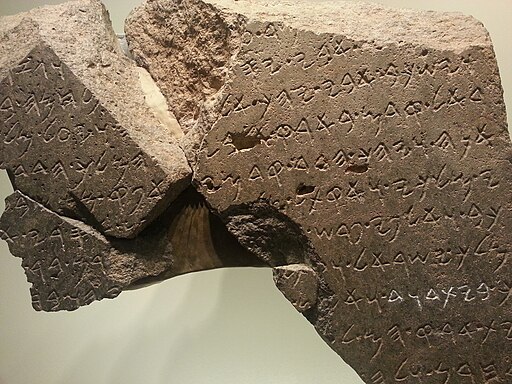
For much of the 20th century, critics of the Bible claimed that King David was little more than a literary invention — a mythic ruler created by later Hebrew writers to give Israel’s monarchy a noble backstory. With no evidence outside Scripture, many grouped David with figures like King Arthur — perhaps a folk hero, but not a verifiable king.
Then, in the 1990s, a broken basalt stone was unearthed in northern Israel and it changed everything.
Known today as the Tel Dan Stele, this 9th-century BCE inscription contains a direct reference to the “House of David.” That single phrase became the first historical evidence outside the Bible that a real dynasty, founded by a ruler named David, was recognized by surrounding nations less than two centuries after his lifetime.
Once again, archaeology moved the goalpost of skepticism: where critics saw myth, the spade unearthed history. Like countless other discoveries before it, the Tel Dan Stele stands as a striking example of how archaeological evidence continues to affirm the historical reliability of Scripture, even in details once dismissed as legend.
🏺 Archaeological Findings
The Tel Dan Stele was unearthed between 1993 and 1994 during excavations led by archaeologist Avraham Biran at Tel Dan in northern Israel. During routine digging, Biran’s team uncovered several fragments of a basalt inscription with the final piece reportedly found by a volunteer sifting through rubble. When the fragments were later assembled, they revealed a line that would rewrite biblical history: the phrase “House of David.”
The inscription, written in ancient Aramaic on a fragmentary basalt stele, dates to the 9th century BCE, within roughly 150 years of King David’s reign. It records the victories of an Aramean king — most likely Hazael of Aram-Damascus — who boasts of defeating “the king of Israel” and “the king of the House of David.”
This remarkable find provides the earliest known historical reference to David outside the Bible, confirming that a Davidic royal house was recognized as a real political entity by neighboring nations. What was once regarded as mythic now stands inscribed in stone — a remarkable witness to the historical foundations of Israel’s monarchy.
📖 Biblical Significance
The Tel Dan Stele bridges the world of biblical text and ancient history. The Bible presents David not only as Israel’s second king but as the founder of a royal line lasting for centuries — a dynasty through which the Messiah was foretold to come (Isaiah 11:1-2, Jeremiah 23:5-6, Jeremiah 33:14-17, Psalm 89:3-4, 29-36).
The phrase “House of David” inscribed on the stele confirms that neighboring kingdoms (likely the Arameans) recognized this dynasty by name. It’s one thing for Scripture to make that claim — it’s another for an enemy nation to record it in stone.
🎓 Scholarly View
This discovery sent ripples through the academic world. Many scholars who once viewed David as a myth had to completely re-evaluate their beliefs. Renowned archaeologist William Dever summarized it this way:
“The Tel Dan Stele provides the first historical reference outside the Bible to David and his dynasty, moving him from legend toward historical reality.”
Even secular scholars now largely agree that a real figure named David existed and founded a dynasty known in the ancient Near East — a dramatic shift from earlier skepticism.
While the debate over David’s existence has mostly ended, some have shifted the question to the extent of his kingdom. Minimalists argue the biblical account exaggerates his power. Yet that skepticism moves the goalpost yet again and often assumes an unrealistic standard of archeological evidence.
The existence of a “House of David” dynasty — feared and named by its enemies — implies a substantial founder and lasting influence. Far from being a tribal chieftain, David clearly established a recognized political entity, one that endured for generations. The Tel Dan Stele anchors that reality in history.
🕵️ Skepticism Before Discovery
Before the 1990s, many “minimalist” scholars claimed that David was purely symbolic — a national legend invented centuries later during Israel’s exile or restoration period. But the Tel Dan discovery forced a dramatic reevaluation.
As the Biblical Archaeology Society observed:
“A single line of text carved nearly 3,000 years ago overturned decades of critical assumptions.”
The discovery didn’t just vindicate Scripture’s mention of David — it revealed how fragile skeptical theories become in light of new evidence. What was once dismissed as myth proved once again to be grounded in historical reality, leaving critics scrambling to redefine their arguments for the limits of biblical history.
🏛️ Why This Discovery Matters: Archaeology and the Reliability of Scripture
The Tel Dan Stele is more than an artifact — it’s a reminder that the Bible stands up to scrutiny. Time and again, archaeology has unearthed names, places, and events once thought to be legendary: the pools of Bethesda and Siloam, the walls of Jericho, the reign of Hezekiah, and now, the dynasty of David.
Each find narrows the space for doubt, showing that the Bible’s historical core is not fantasy but fact. The Tel Dan Stele stands as another concrete witness to the truth of Scripture.
📚 References
- Biblical Archaeology Society. “The Tel Dan Inscription: The First Historical Evidence of King David from the Bible.” Accessed October 4, 2025.
- The Times of Israel. “Tel Dan Stele, oldest archaeological evidence of King David, comes to NY’s Jewish Museum.” Accessed October 4, 2025.
- Biran, Avraham and Joseph Naveh. The Aramaic Language and Its Dialects. (Hebrew Union College Annual, Vol. 65, 1994).
- Tel Dan Stele Fragment A. Photo by Israel Antiquities Authority, via Wikimedia Commons. Available here.

Leave a Reply